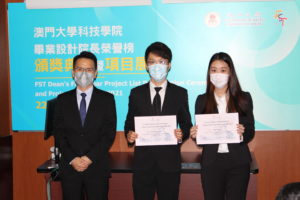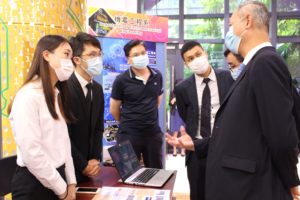Stainless steels are commonly used in fresh water and sea water. AISI 304, as one of the most frequently used types of stainless steels, are corrosion resistant and perform well in freshwater. However, as AISI 304 being used under seawater, salt concentration also needs to be considered as chloride may initiate the pitting corrosion. If stainless steel is immersed in sea water for a long time, it may cause corrosion due to chloride. Furthermore, the friction capacity of AISI 304 are poor, under corrosive conditions, the adhesive and abrasive wear will occur causing surface damage, accelerating the corrosion and shortening its service lifetime. One of the cost effective method is using surface coating to achieve high corrosion and wear resistances. Lam Wai I and Leong Ka Kit are 2020/2021 excellent undergraduates in the Department of Electromechanical Engineering. Their final year project is about fabrication of corrosion and wear resistant coatings via friction surfacing for marine applications. When friction surfacing is used below the melting temperature, a high-performance nickel-based coating is made on AISI 304 stainless steel based on thermal/plastic deformation. Friction surfacing is optimized to produce defect-free, thick and metallurgical bonding coatings. On the other hand, two of them were using several methods, such as scanning electron microscope/electron backscatter diffraction, electrochemical testing and ball-disk wear to study the microstructure, corrosion resistance and wear resistance of the friction surfacing coating. Their work was successfully selected as one of the “Best Projects”.
Lam Wai I and Leong Ka Kit mentioned that the biggest challenge of this project are that the research in this area is relatively complicated, it takes time to study and reflect the result of friction surfacing. ‘Although the preparation process is very difficult, they find it very valuable to have such learning experiences that could not be acquired in books.’ Leong Ka Kit says. In the past four years, they also participated into the exchange program provided by UM. During the six months of studying in Sweden, they can felt the different learning cultures in foreign countries, which benefited them a lot and enriched their university life. In the future, they will study a master’s degree in UM and seek development opportunities in their future path.
現時不銹鋼被廣泛應用在淡水中及海水中,作為最常用不銹鋼類型之一,AISI 304具有耐腐蝕性,在淡水中表現良好。但在海水中則需要考慮鹽的濃度,若不銹鋼長時間浸泡在海水或船體等難以清潔的位置,可能會因為氯化物引發腐蝕。此外,AISI 304 的摩擦學性能較差,在腐蝕條件下,會發生粘附和磨料磨損,造成表面損傷,加速腐蝕並縮短不銹鋼的使用壽命。考慮到成本等因素,表面塗層是實現高耐腐蝕性和耐磨性的有效替代方案。林慧怡及梁嘉杰是2020/2011學年機電工程系的優秀本科畢業生,兩人的畢業設計作品正是運用摩擦堆焊製造出能應用於海水的不銹鋼耐腐蝕層和耐磨塗層。當摩擦堆焊應用在低於熔化溫度下,基於熱/塑性變形製造高性能鎳基塗層於AISI 304不鏽鋼上。摩擦堆焊經過優化,即可產生無缺陷、厚且冶金結合的塗層。其次,二人對摩擦堆焊塗層的微觀結構、耐腐蝕性和耐磨性使用了掃瞄電子顯徹鏡/電子背散射衍射、電化學測試和球盤磨損等方式進行研究。他們的作品成功獲選成為「最佳優秀作品項目」之一。
林慧怡及梁嘉杰提及畢業設計作品最大挑戰是相關研究相對複雜,需要花費較多時間和精力去研讀新內容,以更好地表達摩擦堆焊的效果。二人同時也要處理各項分工及其他問題,梁嘉杰表示:「儘管準備的過程十分艱辛,但能夠深入體驗、親自動手、實地操作及收穫書本上沒有的知識,都覺得十分難能可貴。」過去四年,兩人也曾參與由澳大提供的交換生計劃。到瑞典留學半年期間,深深地感受到外國與別不同的學習文化,令他們獲益匪淺,也豐富了他們的大學生涯。未來他們將一邊在澳大升讀機電工程系碩士,另一方面則積極尋找更多機會實踐自身能力。
二人的作品獲選成為「最佳優秀作品項目」
Their project was selected as one of the ‘Best Projects’
二人在成果展上向嘉賓展示作品
They introduced their project to
guests on the exhibition show



